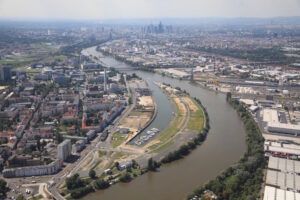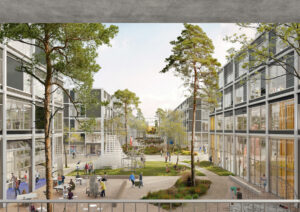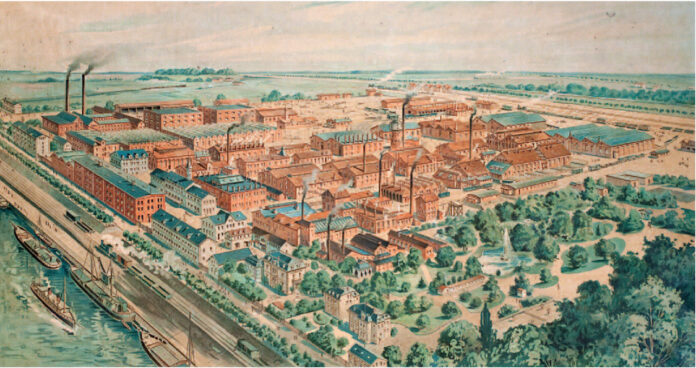Located in the federal state of Hesse, Offenbach borders on Frankfurt: the towers of the ECB, European Central Bank, stand between their two river ports. Of Offenbach’s 144,000 inhabitants, more than 40 per cent are foreigners: at the 2016 Venice Biennale, it was proclaimed as the “Arrival City”, a tribute to its hospitality and multi-ethnicity.
Offenbach Am Main has been home to leather, chemical, metal and oil industries, printing and tobacco: Oelher was awarded a prize at the World Exhibition in London in 1862 for its syntheticblue dyes and was renowned for its “social” factory model; Klingspor made it the second capital of printing after Mainz; and Heyne patented a machine for the mass-production of screws. In 1917 Rowenta launched its first toaster followed by the steam iron in 1957. The ILM, the most important international leather goods fair, was launched in wake of its industrial vocation for leather, and the “Deutsches Leder und Schuh Museum” (Museum of Leather and Shoe Manufacturing) was founded in 1917. In 1952, the DWD (Deutscher Wetterdienst), the weather service centre serving Germany, was established in the city.
Other business recently founded here include Falken Tyres Europe, the Japanese tyre giant and its South Korean competitor Kumho Tyre, the Hyundai Motor Company Europe with its logistics associate Glovis and Stark that manufactures building materials (formerly Saint-Gobain Building Distribution) employing 6,000 staff. Two other key innovation companies, Samson AG, the world’s leading manufacturer of intelligent control valves, and BioSpring, biotechnology and pharmaceuticals, will soon be setting up office, too.

The HfG, Hochschule für Gestaltung, known as Hesse State University of Art and Design since 1970, was founded in Offenbach in 1832: initially a craft school and then one of the most important arts and crafts schools in Germany with links to Bauhaus and Ulm. It is moving from its current site, which has been expanded several times and incorporates Isenburg Castle, to the river port along the Main, one of three strategic areas in the city’s latest redevelopment plan: all that remains of the old block of fuel depots and port facilities is a 26-metre blue crane complete with viewing platform, surrounded by residential and services buildings.
Hessen acquired a 15,000 m2 plot of land for the new headquarters, and an invitation-only competition was launched with all kinds of detailed constraints. Of the 21 projected entered in the competition, the panel of judges chose the one developed by XDGA Xaveer de Geyter Architects (Brussels) together with Topotek 1 Architektur GmbH (Zurich, Berlin): a flexible and non-invasive architectural design, a kind of base camp for excursions to the frontiers of creativity, rigorously designed with now trendy features. The layout, structured around a rectangular courtyard-garden, is cut through a view of the landscape referred to in the masterplan, which serves as “a connection between Ludwigstrasse and the harbour basin, while also providing a natural entrance way”.
Stylistically incorporated in the port’s residential facilities, the building is transparent inside and faces towards the city; the goals of maximum environmental sustainability and high-quality climatic/lighting/acoustic ratings and materials are successfully provided by a design that focuses on the performance ratings of the most sophisticated materials and technologies rather than any eye-catching formal features.
Bernd Kracke, president of the HfG since 2006, has drawn on his international study/work experience, including his time at MIT (USA), to make it an expansive hub of culture and education, an experiential and experimental bridge between the tangible and intangible, criss-crossing the boundaries of cross-media. “For the first time in the history of the HfG”, Bernd told me, all disciplines, studios, workshops and student accommodation will be brought together on one campus”. But this is not a separating of the institute from its surroundings, as testified by the fact that the Hfg recently took over Höchster porcelain factory (founded in 1746), “traditional expertise with materials and manual skills can continue hand in hand with new digital language” a theme that inspired the avant-garde content of the B3 programme from 2015 entitled Expanded Senses.
Frankfurt’s B3, Biennial of Moving Images, an international event for digital art and cross-media – now an annual event – is organised by the HfG and is something lese Bernd Kracke devised in partnership with the artist Rotraut Pape. The 2023 edition’s content and title were Horizons: “once completed in 2029, the new campus will provide a spectacular home for B3 and link up with our artificial intelligence and robotics laboratories”.
Construction of the new campus will begin in 2026, the year when Frankfurt will be World Design Capital under the motto “Design for Democracy” reaching new horizons on the cusp of the future.

A Offenbach la nuova sede
Nello Stato federale dell’Assia, Offenbach confina con Francoforte: tra i loro due porti fluviali svettano le torri della BCE, Banca Centrale Europea. Dei 144.000 abitanti di Offenbach oltre il 40% sono stranieri: alla Biennale di Venezia del 2016 è stata proclamata “Arrival City” un tributo all’accoglienza e alla multietnicità.
Offenbach Am Main è stata sede di industrie del cuoio, della chimica, dei metalli e del petrolio, della tipografia e del tabacco: dalla Oelher, premiata all’Esposizione Mondiale di Londra nel 1862 per i suoi coloranti blu sintetici e nota per il modello di fabbrica “sociale”, alla Klingspor che ne fece la seconda capitale della tipografia dopo Magonza, fino alla Heyne che brevettò una macchina per la produzione seriale delle viti. Nel 1917 la Rowenta lanciò il suo primo tostapane e nel 1957 il ferro a vapore. Sulla vocazione industriale del cuoio (cui si deve nel 1917 il Deutsches Leder und Schuh Museum, Museo della lavorazione del cuoio e della calzatura) è poi nata l’ILM, la più importante fiera internazionale della pelletteria. Nel 1952 fu costituito il DWD (Deutscher Wetterdienst) il centro di servizio meteorologico al servizio della Germania.
Di recente si sono insediate la Falken Tyres Europe, colosso degli pneumatici giapponese e la concorrente Kumho Tyre sudcoreana, la Hyundai Motor Company Europe con l’associata Glovis della logistica e la Stark per i materiali da costruzione (ex Saint-Gobain Building Distribution) con 6.000 dipendenti. A breve vi approderanno altre due aziende chiave dell’innovazione, la Samson AG, primo produttore al mondo di valvole di controllo intelligenti e la BioSpring, biotecnologie e farmaceutica.
HfG, Hochschule für Gestaltung, dal 1970 Università statale di Arte e Design dell’Assia, fu fondata a Offenbach nel 1832: all’inizio scuola artigiana, poi di arti e mestieri tra le più importanti in Germania con riferimenti al Bauhaus e a Ulm. Dalla sua attuale sede, più volte ampliata e che ingloba il Castello di Isenburg, si trasferirà nel porto fluviale sul Meno, una delle tre aree strategiche del piano di recupero della città: della preesistente concentrazione di depositi di carburante e impianti portuali sopravvive oggi la solitaria testimonianza della gru azzurra di 26 m dotata di piattaforma panoramica, circondata da edifici ad uso residenziale e terziario.
Per realizzare la nuova sede l’Assia ha acquistato un terreno di 15.000 m2 e per il progetto è stato bandito un concorso ad inviti con dettagliati constraints. Tra i 21 progetti partecipanti la giuria ha scelto quello sviluppato dallo studio XDGA Xaveer de Geyter Architects (Bruxelles) insieme a Topotek 1 Architektur GmbH (Zurigo, Berlino): un’architettura flessibile e non invasiva, una sorta di campo-base per escursioni alle frontiere delle creatività, quindi rigoroso ed esente da scelte formali di tendenza. L’impianto, strutturato attorno a una corte-giardino rettangolare, è tagliato da un asse visivo paesaggistico già prescritto dal masterplan che funge da “collegamento tra Ludwigstrasse e il bacino portuale nonché da ingresso naturale”. Integrato stilisticamente alle residenze del porto, l’edificio è trasparente al proprio interno e verso la città; gli obiettivi della massima sostenibilità ambientale e delle prestazioni climatiche, luminose, acustiche e materiche, sono affidate a una scelta progettuale che alla visibilità delle dichiarazioni formali preferisce la performanza dei materiali e delle tecnologie più sofisticate.
Bernd Kracke, presidente della HfG dal 2006, ha attinto alla sua esperienza internazionale di studio e di lavoro inclusa la sua permanenza al MIT (USA), per farne un nucleo espansivo di cultura e formazione, un ponte esperienziale e sperimentale tra materiale e immateriale, oltre i confini della cross-medialità. “Per la prima volta nella storia dell’HfG” mi dice Bernd “tutte le discipline, gli studi, le officine, i laboratori, gli alloggi per gli studenti verranno riuniti in un unico campus”. Ma questa non è una separazione dal territorio, tanto è vero che Hfg ha acquisito di recente la fabbrica di porcellana Höchster (nata nel 1746) perché “la tradizione materiale e la manualità vadano di pari passo con i nuovi linguaggi digitali”, un tema che ispirò i contenuti di avanguardia della B3 del 2015, dal titolo Expanded Senses.
La B3 di Francoforte, Biennale dell’Immagine in movimento, appuntamento internazionale di arte digitale e crossmedialità – ora annuale – è organizzata dalla HfG ed è l’altra creatura che Bernd Kracke ha ideato insieme all’artista Rotraut Pape. L’edizione 2023 ha avuto per contenuti e titolo Horizons: “una volta terminato nel 2029, il nuovo campus potrà essere una sede spettacolare della B3 e ricongiungersi ai nostri laboratori di intelligenza artificiale e robotica”. La costruzione del nuovo campus inizierà nel 2026, anno in cui Francoforte sarà World Design Capital con la candidatura “Design for Democracy”: altri orizzonti che si toccano, sulla soglia del futuro.
A shared article, a collaboration between L’Arca International n. 177 (03-04, 2024) and FYINpaper








